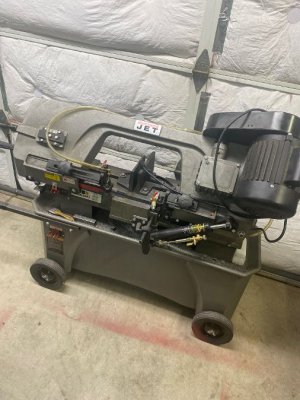- Joined
- Mar 26, 2018
- Messages
- 8,643
Hey all,
I cut some stainless steel the other day. It was 303-304? - 2 1/2" in diameter and it took about ten minutes.
I don't remember what brand this blade is but it's been on the saw for a couple years.
I use this saw for low carbon steel, alloy steels, aluminum and stainless steel.
I don't cut anything under .250" as a rule.
The blade I have been so happy with is 14 TPI, and It's one of those anti-vibration blades. Different sized teeth.
The blade specs in the manufacturer's manual calls for a: (Jet 7 x 12)
3/4" x .032" x 93"
Blade speeds, SFPM-86, 132, 178, 260
I checked online this morning. The prices run from $21 to $171.
The brands, to name a few,
Starrett
Olsen
Lenox
FoxBC
Supercut
Imachinist
My question----- What do you suggest? I just want the best blade, I don't care if I spend a little bit more if they last two years.
Thank you for your thoughts!!
Jeff
I cut some stainless steel the other day. It was 303-304? - 2 1/2" in diameter and it took about ten minutes.
I don't remember what brand this blade is but it's been on the saw for a couple years.
I use this saw for low carbon steel, alloy steels, aluminum and stainless steel.
I don't cut anything under .250" as a rule.
The blade I have been so happy with is 14 TPI, and It's one of those anti-vibration blades. Different sized teeth.
The blade specs in the manufacturer's manual calls for a: (Jet 7 x 12)
3/4" x .032" x 93"
Blade speeds, SFPM-86, 132, 178, 260
I checked online this morning. The prices run from $21 to $171.
The brands, to name a few,
Starrett
Olsen
Lenox
FoxBC
Supercut
Imachinist
My question----- What do you suggest? I just want the best blade, I don't care if I spend a little bit more if they last two years.
Thank you for your thoughts!!
Jeff
Attachments
Last edited:


 I used Lenox in the past with good results on the horizontal .
I used Lenox in the past with good results on the horizontal .